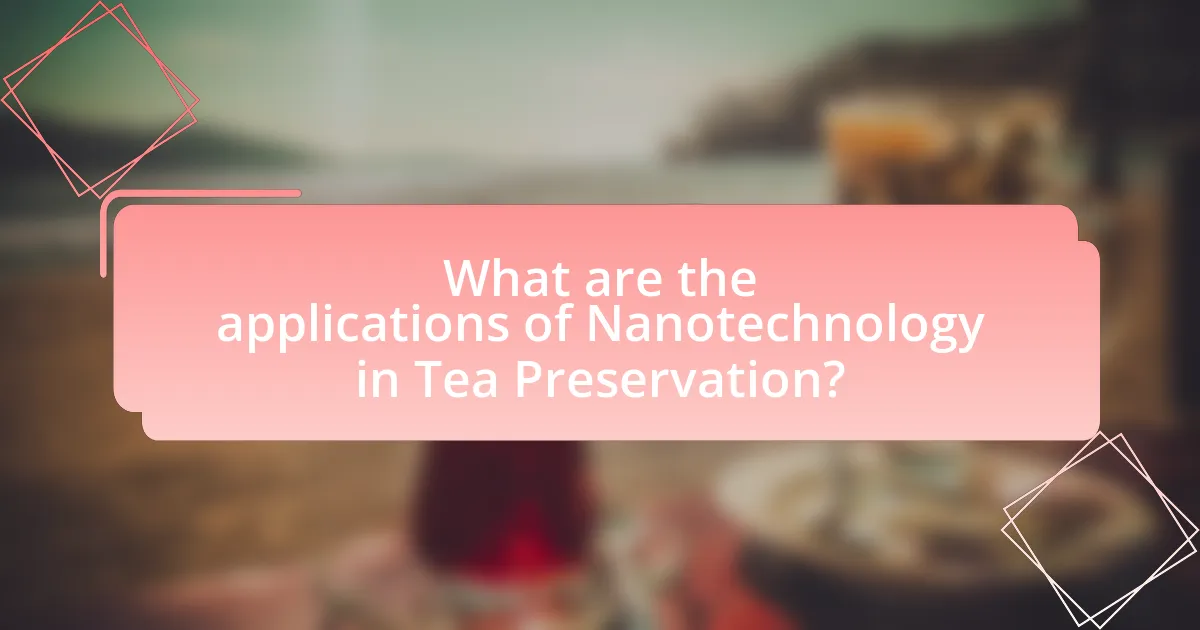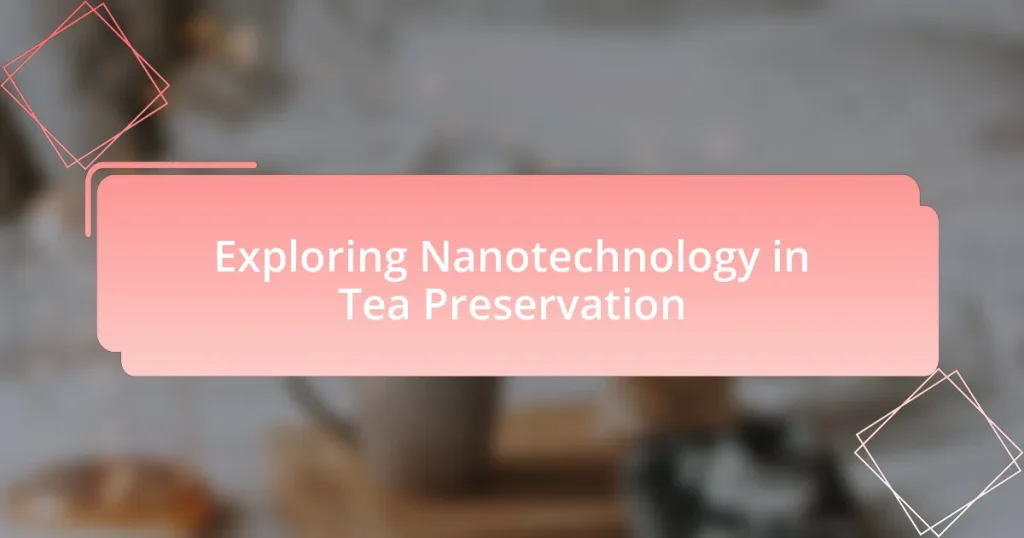Nanotechnology in tea preservation involves the use of nanomaterials to enhance the shelf life and quality of tea by improving packaging, storage, and delivery methods. Key nanomaterials such as silver, zinc oxide, and chitosan nanoparticles play a crucial role in preventing oxidation and microbial growth, thereby maintaining the flavor and nutritional content of tea. The article discusses how these nanomaterials interact with tea components, the importance of effective preservation techniques, and the challenges and future prospects of implementing nanotechnology in tea preservation. Additionally, it highlights best practices for utilizing nanotechnology to ensure the safety and efficacy of preserved tea products.

What is Nanotechnology in Tea Preservation?
Nanotechnology in tea preservation refers to the application of nanomaterials and techniques to enhance the shelf life and quality of tea. This technology utilizes nanoparticles to improve the packaging, storage, and delivery of tea, effectively reducing oxidation and microbial growth. For instance, studies have shown that using nanocomposite films for packaging can significantly extend the freshness of tea by providing better barrier properties against moisture and oxygen, which are critical factors in tea degradation.
How does nanotechnology enhance the preservation of tea?
Nanotechnology enhances the preservation of tea by utilizing nanoscale materials to improve packaging and storage methods. These materials can create barriers that protect tea from moisture, oxygen, and light, which are key factors in the degradation of tea quality. For instance, nanocomposite films made from materials like chitosan and silver nanoparticles have been shown to possess antimicrobial properties, thereby extending the shelf life of tea by preventing microbial growth. Research published in the Journal of Agricultural and Food Chemistry demonstrates that such nanotechnology applications can significantly reduce the oxidation process in tea, preserving its flavor and nutritional content over time.
What are the key nanomaterials used in tea preservation?
The key nanomaterials used in tea preservation include silver nanoparticles, zinc oxide nanoparticles, and chitosan nanoparticles. Silver nanoparticles are known for their antimicrobial properties, which help inhibit the growth of bacteria and fungi in tea, thereby extending its shelf life. Zinc oxide nanoparticles possess antioxidant properties that can protect tea from oxidative degradation, preserving its flavor and nutritional quality. Chitosan nanoparticles, derived from chitin, also exhibit antimicrobial effects and can form protective coatings around tea leaves, further enhancing preservation. These nanomaterials have been validated through various studies demonstrating their effectiveness in maintaining the quality and safety of tea during storage.
How do these nanomaterials interact with tea components?
Nanomaterials interact with tea components primarily through adsorption and stabilization processes. These interactions enhance the bioavailability of beneficial compounds in tea, such as polyphenols and catechins, by preventing their degradation and improving their solubility. For instance, studies have shown that silver nanoparticles can bind to catechins, thereby protecting them from oxidation and extending their antioxidant properties. Additionally, the incorporation of nanomaterials like silica nanoparticles can improve the dispersion of tea extracts, leading to better flavor and aroma retention. This evidence highlights the significant role of nanomaterials in enhancing the quality and preservation of tea.
Why is tea preservation important?
Tea preservation is important because it maintains the quality, flavor, and nutritional properties of tea over time. Proper preservation techniques prevent degradation caused by factors such as light, moisture, and air exposure, which can lead to loss of essential oils and antioxidants. For instance, studies have shown that exposure to oxygen can significantly reduce the levels of catechins, key antioxidants in tea, by up to 50% within a few months. Therefore, effective preservation methods are crucial for ensuring that tea retains its intended taste and health benefits for consumers.
What factors contribute to the degradation of tea quality?
Factors that contribute to the degradation of tea quality include exposure to light, moisture, oxygen, and temperature fluctuations. Light can cause the degradation of chlorophyll and other pigments, leading to a loss of flavor and color. Moisture promotes the growth of mold and bacteria, which can spoil the tea. Oxygen exposure leads to oxidation, resulting in stale flavors and diminished aroma. Temperature fluctuations can accelerate chemical reactions that degrade essential oils and compounds in tea. Studies have shown that maintaining optimal storage conditions significantly preserves tea quality, highlighting the importance of controlling these factors.
How does proper preservation affect tea flavor and aroma?
Proper preservation significantly enhances tea flavor and aroma by preventing oxidation and degradation of volatile compounds. When tea is stored in airtight containers away from light, moisture, and heat, it maintains its essential oils and aromatic compounds, which are crucial for flavor. Research indicates that exposure to air can lead to the loss of these compounds, resulting in stale or flat-tasting tea. For instance, a study published in the Journal of Agricultural and Food Chemistry found that proper storage conditions can retain up to 90% of the tea’s original flavor profile over time. Thus, effective preservation techniques are vital for maintaining the quality and sensory attributes of tea.

What are the applications of Nanotechnology in Tea Preservation?
Nanotechnology is applied in tea preservation primarily through the development of nanomaterials that enhance the stability and shelf life of tea products. These applications include the use of nano-encapsulation techniques to protect bioactive compounds, such as catechins and polyphenols, from degradation due to environmental factors like light, oxygen, and moisture. For instance, studies have shown that encapsulating these compounds in nanocarriers can significantly improve their stability and bioavailability, thereby maintaining the tea’s flavor and health benefits over time. Additionally, nanotechnology enables the creation of antimicrobial coatings for packaging materials, which can inhibit microbial growth and further extend the shelf life of tea products.
How is nanotechnology applied in packaging for tea?
Nanotechnology is applied in packaging for tea primarily through the development of nanocomposite materials that enhance barrier properties, ensuring better protection against moisture, oxygen, and light. These advanced materials, often incorporating nanoparticles such as clay or silica, significantly improve the shelf life and freshness of tea by preventing degradation caused by environmental factors. Research has shown that these nanocomposite films can reduce the permeability of gases and vapors, thus maintaining the quality and flavor of tea for extended periods.
What types of nanostructured packaging materials are used?
Nanostructured packaging materials used in tea preservation include nanocomposites, nanolayers, and biodegradable films. These materials enhance barrier properties against moisture, oxygen, and light, which are critical for maintaining the quality of tea. For instance, nanocomposite films, often made from polymers combined with nanoparticles like clay or silica, significantly improve mechanical strength and thermal stability. Research has shown that incorporating nanomaterials can reduce the permeability of packaging, thereby extending the shelf life of tea products.
How do these materials improve shelf life and freshness?
Nanotechnology materials improve shelf life and freshness by creating protective barriers that inhibit microbial growth and oxidation. These materials, such as nanoclays and silver nanoparticles, enhance the stability of tea by reducing moisture absorption and preventing the degradation of flavor compounds. Studies have shown that tea packaged with nanotechnology-based materials can maintain quality for longer periods, with research indicating that such packaging can extend shelf life by up to 50% compared to conventional methods.
What role does nanotechnology play in maintaining tea’s nutritional value?
Nanotechnology plays a crucial role in maintaining tea’s nutritional value by enhancing the bioavailability of its beneficial compounds. Through the use of nanoparticles, such as those derived from chitosan or silica, the stability and solubility of polyphenols and catechins in tea can be significantly improved. Research indicates that these nanoparticles can encapsulate these compounds, protecting them from degradation during processing and storage, thereby preserving their antioxidant properties. For instance, a study published in the Journal of Agricultural and Food Chemistry demonstrated that encapsulated catechins showed a higher retention rate compared to non-encapsulated forms, confirming that nanotechnology effectively safeguards the nutritional integrity of tea.
How do nanoparticles protect antioxidants in tea?
Nanoparticles protect antioxidants in tea by encapsulating them, which enhances their stability and bioavailability. This encapsulation process prevents the degradation of antioxidants due to environmental factors such as light, heat, and oxygen exposure. Research has shown that using silica or lipid-based nanoparticles can significantly improve the retention of catechins, a type of antioxidant found in tea, thereby preserving their beneficial properties during storage and processing. For instance, a study published in the Journal of Agricultural and Food Chemistry demonstrated that tea extracts encapsulated in nanoparticles exhibited a higher antioxidant activity compared to non-encapsulated extracts, confirming the protective role of nanoparticles in maintaining the efficacy of tea antioxidants.
What are the implications for health benefits of preserved tea?
Preserved tea offers significant health benefits primarily due to its enhanced antioxidant properties and extended shelf life. The preservation process, often utilizing nanotechnology, helps retain and even amplify the bioactive compounds such as catechins and flavonoids, which are known for their anti-inflammatory and anti-cancer effects. Research indicates that preserved tea can maintain higher levels of these beneficial compounds compared to non-preserved varieties, leading to improved cardiovascular health and better metabolic function. For instance, a study published in the Journal of Agricultural and Food Chemistry found that nanotechnology in tea preservation can increase the stability of polyphenols, thereby enhancing their health-promoting effects.

What are the challenges and future prospects of Nanotechnology in Tea Preservation?
The challenges of nanotechnology in tea preservation include regulatory hurdles, potential toxicity, and the need for extensive research to ensure safety and efficacy. Regulatory frameworks for nanomaterials are still developing, which can delay the approval of nanotechnology applications in food preservation. Additionally, some nanoparticles may pose health risks if not properly assessed, necessitating rigorous safety evaluations. Future prospects for nanotechnology in tea preservation are promising, as advancements in nanomaterials could enhance shelf life, maintain flavor, and improve antioxidant properties. Research indicates that using nanotechnology can effectively encapsulate active compounds, thereby protecting them from degradation and enhancing their delivery in tea products.
What challenges exist in the implementation of nanotechnology for tea preservation?
The challenges in the implementation of nanotechnology for tea preservation include regulatory hurdles, potential toxicity, and cost-effectiveness. Regulatory hurdles arise from the need for extensive safety assessments and compliance with food safety standards, which can delay the approval process for nanotechnology applications. Potential toxicity concerns stem from the unknown effects of nanoparticles on human health and the environment, necessitating thorough research to ensure safety. Additionally, the cost-effectiveness of integrating nanotechnology into tea preservation methods must be evaluated, as high production costs could limit widespread adoption. These challenges highlight the complexities involved in advancing nanotechnology for effective tea preservation.
How do regulatory concerns impact the use of nanotechnology?
Regulatory concerns significantly impact the use of nanotechnology by imposing strict guidelines that govern its development and application. These regulations are designed to ensure safety, efficacy, and environmental protection, which can slow down innovation and increase costs for researchers and companies. For instance, the U.S. Environmental Protection Agency (EPA) and the Food and Drug Administration (FDA) have established frameworks for assessing the risks associated with nanomaterials, requiring extensive testing and documentation before products can reach the market. This regulatory scrutiny can lead to delays in product development and limit the scope of nanotechnology applications in sectors like food preservation, including tea preservation, where safety and consumer health are paramount.
What are the potential risks associated with nanomaterials in food products?
The potential risks associated with nanomaterials in food products include toxicity, environmental impact, and unintended health effects. Toxicity arises because nanoparticles can penetrate biological membranes and interact with cellular structures, potentially leading to adverse reactions. For instance, studies have shown that certain metal nanoparticles can induce oxidative stress and inflammation in human cells. Environmental impact is a concern as nanomaterials may accumulate in ecosystems, affecting soil and water quality. Research indicates that nanoparticles can disrupt microbial communities essential for ecosystem health. Unintended health effects may occur due to the lack of comprehensive understanding of how nanomaterials behave in biological systems, leading to potential long-term health risks that are not yet fully understood.
What does the future hold for nanotechnology in tea preservation?
The future of nanotechnology in tea preservation is promising, with advancements expected to enhance shelf life and maintain flavor integrity. Nanotechnology can facilitate the development of nano-coatings that protect tea from moisture and oxygen, which are primary factors in degradation. Research indicates that nanoparticles can be used to encapsulate volatile compounds in tea, preserving their aroma and taste for longer periods. For instance, a study published in the Journal of Agricultural and Food Chemistry demonstrated that nano-encapsulation significantly improved the stability of essential oils in food products, suggesting similar applications for tea. As these technologies evolve, they are likely to lead to more effective preservation methods, ensuring higher quality and longer-lasting tea products.
How can advancements in nanotechnology improve tea preservation methods?
Advancements in nanotechnology can significantly improve tea preservation methods by utilizing nanomaterials to enhance the barrier properties of packaging. These nanomaterials, such as nanoclays and nanoparticles, can create packaging that is more effective at blocking moisture, oxygen, and light, which are key factors in the degradation of tea quality. For instance, research has shown that incorporating nanoclays into polymer films can reduce oxygen permeability by up to 90%, thereby extending the shelf life of tea products. Additionally, nanoscale coatings can be applied to tea leaves themselves to provide antimicrobial properties, further preserving freshness and flavor.
What trends are emerging in the research of nanotechnology for food preservation?
Emerging trends in the research of nanotechnology for food preservation include the development of nanocomposite films, the use of nanoparticles for antimicrobial properties, and the application of nanosensors for monitoring food quality. Nanocomposite films, which incorporate materials like silver or zinc oxide nanoparticles, enhance barrier properties and extend shelf life by preventing microbial growth. Research indicates that these films can significantly reduce spoilage in various food products, including tea. Additionally, nanoparticles such as chitosan and essential oils are being explored for their ability to inhibit bacterial growth, further improving food safety. Nanosensors are also gaining attention for their capability to detect spoilage indicators in real-time, allowing for better management of food storage conditions. These advancements are supported by studies demonstrating improved preservation outcomes and enhanced food safety, making nanotechnology a promising avenue in food preservation research.
What best practices should be followed for using nanotechnology in tea preservation?
Best practices for using nanotechnology in tea preservation include employing nano-encapsulation techniques to enhance the stability and bioavailability of antioxidants in tea. This method protects sensitive compounds from degradation due to light, heat, and oxygen exposure, thereby prolonging shelf life. Research indicates that nano-encapsulation can significantly improve the retention of polyphenols, which are crucial for tea’s health benefits. Additionally, utilizing biodegradable nanomaterials for packaging can minimize environmental impact while maintaining tea quality. Studies have shown that such packaging can effectively reduce moisture and oxygen permeability, further preserving the tea’s flavor and aroma.


